The hoots and screeches of a waking jungle drift through the trees: a chorus of hornbills, shikras and fanatical cockerels, the excited chatter of early risers in anticipation of the day. In the pre-dawn gloom, the sound of other humans is conspicuously absent. Here on the eastern side of Angkor Wat, the legendary Khmer temple deep in the forests of northwestern Cambodia, sunrise begins to bathe the tips of pinecone-shaped towers in liquid gold. The veil of shadow gradually falls, revealing colonnaded corridors, sheer staircases and the soaring lotus-bud peaks that crown this 900-year-old temple.
The story of Angkor — the vast UNESCO World Heritage site that was home to the capitals of the Khmer Empire for almost 600 years — is faithfully told in its art and architecture, from the intricately carved bas-reliefs of its innumerable temples to the elaborate system of canals and reservoirs built to support a rapidly growing population.

Sprawling across more than 400 square kilometres to the north of Cambodia’s Tonlé Sap lake and the riverside city of Siem Reap, Angkor was home to some 800,000 people at its zenith — around 10 times more than London at the same time — before it was rapidly abandoned in the 15th century; a final chapter that remains a mystery.
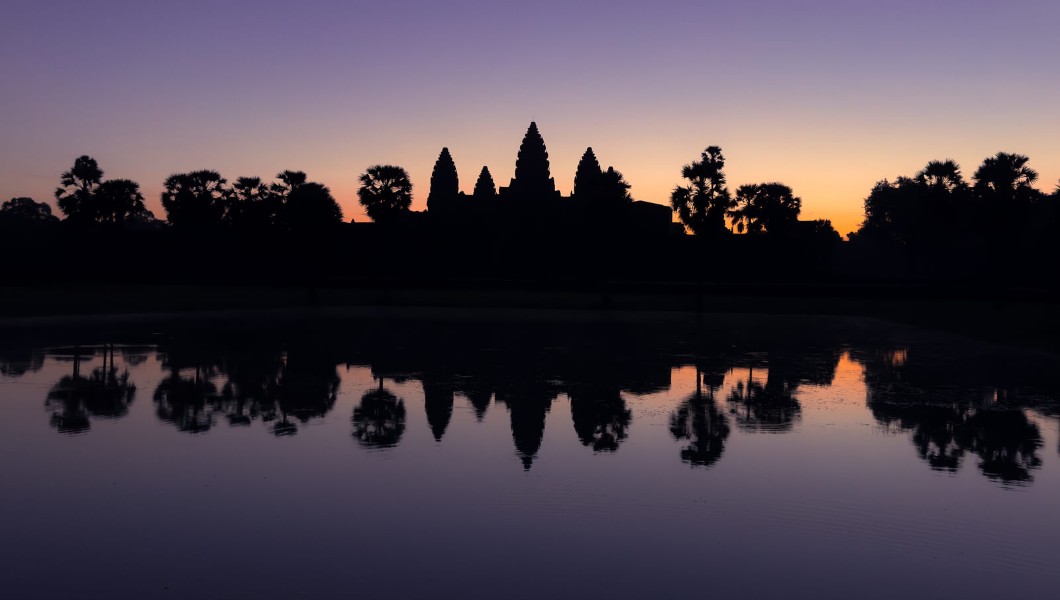
While the crowds gather on the far side of the temple, jostling to capture the iconic shot of Angkor Wat silhouetted by sunrise, the much more intimate eastern entrance where I’m standing is accessible to all, yet known by just a few. The entire façade is awash in warm morning sunshine by the time another visitor disturbs the moment, an unfathomably secluded introduction to the treasures of this once-forgotten empire.
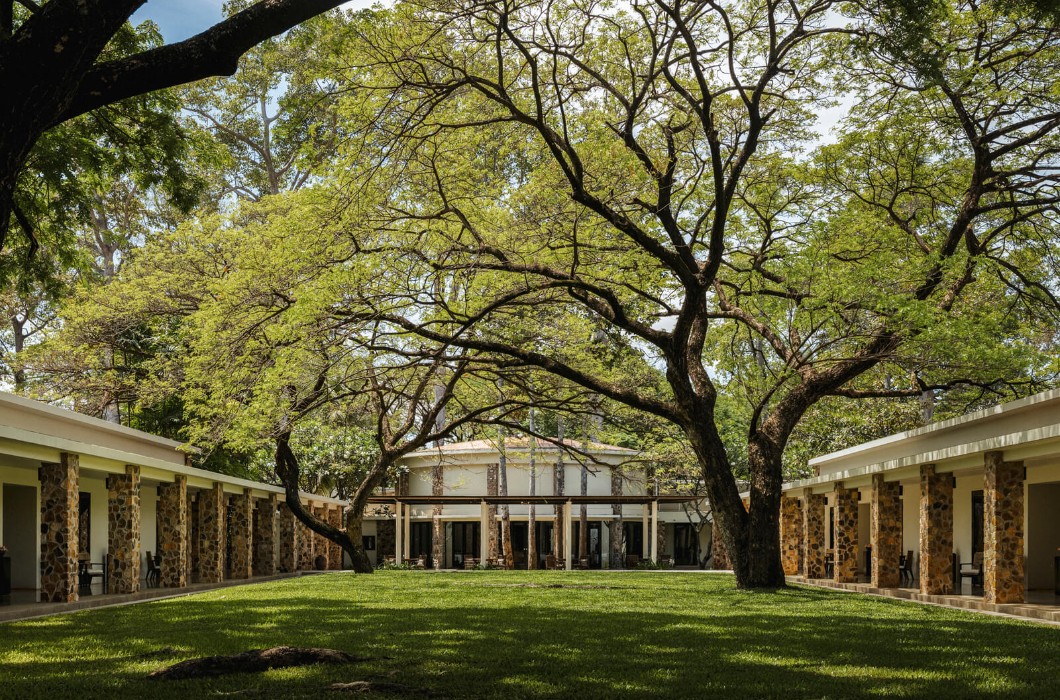
Such is the insider knowledge afforded to travellers staying at Amansara, the former royal guesthouse of King Norodom Sihanouk. Built in the 1960s, Villa Princière, as it was then known, fell into neglect during the Khmer Rouge uprising and its reign of terror.
After an extensive renovation at the hands of long-term Aman partner Kerry Hill, it reopened in 2002 as Amansara, a hybrid of Aman, meaning peace in Sanskrit, and apsara, the dancing ‘heavenly nymphs’ that appear regularly in Hindu and Buddhist mythology and scenes etched into the sandstone walls of Angkor Wat.

A sumptuous expression of New Khmer architecture tinged with tropical modernism, the hotel is overlooked by giant fig trees whose branches cast dappled sunlight onto a flawless lawn and terrace, where evening cocktails are accompanied by a chorus of cicadas. Quiet, calm and discrete, the hotel retains its royal sensibilities including the original ebony swimming pool and a restaurant where Khmer cuisine is presented beneath a vast domed roof. Modern additions like the Aman Spa do nothing to dampen the heritage feel, which is enhanced by a fleet of black vintage remorks (Cambodian tuk-tuks) and an original 1963 Mercedes-Benz that belonged to the king — now used for short journeys around Siem Reap.
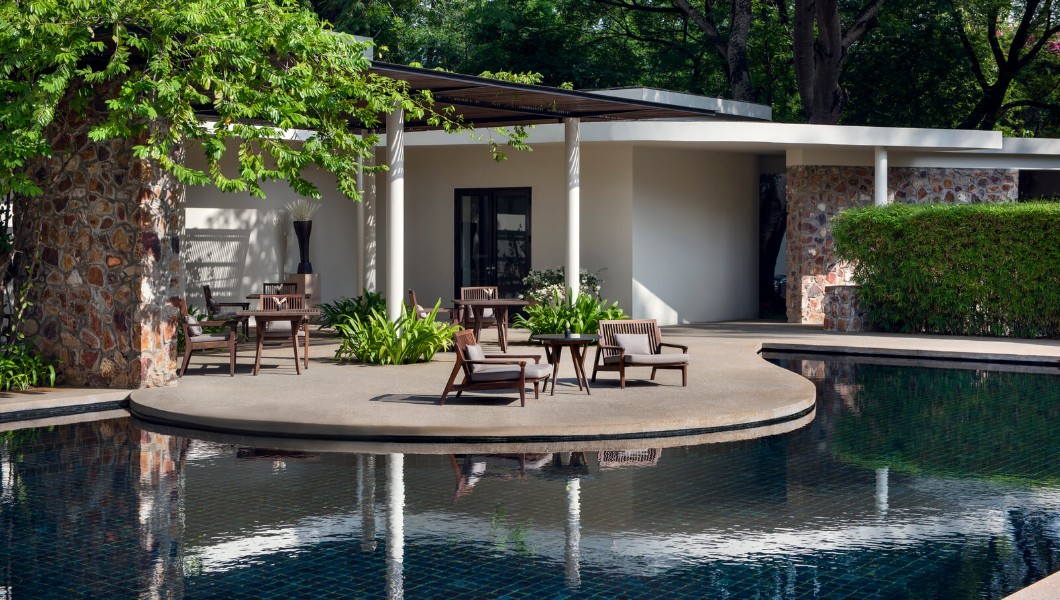
The private courtyard of my Pool Suite pushes Aman’s minimalist aesthetic to its limit; an open-air gallery space with stark white walls and a dark-stone pool that mirrors the long-legged palm trees towering overhead. Monochrome interiors with saffron splashes are perfumed with the delicate scent of jasmine flowers, artfully folded lotus petals add a dash of pastel pink and yellow to the scene, and a Bodhi tree sculpted into the wall roots the suite in its natural surroundings, a soothing escape from the bustle of Siem Reap.
STORIES SET IN STONE
Back at Angkor Wat, the sun is up and the multitudes begin to pour over the ancient monument. My veteran guide, Tone, plots a relatively quiet path through the web of open-sided galleries and their remarkable stone carvings. Commissioned in the 12th century by King Suryavarman II, Angkor Wat is the largest temple in Angkor Archaeological Park; a declaration of devotion for the Hindu god Vishnu which took hundreds of thousands of workers and artisans 30 years to build.
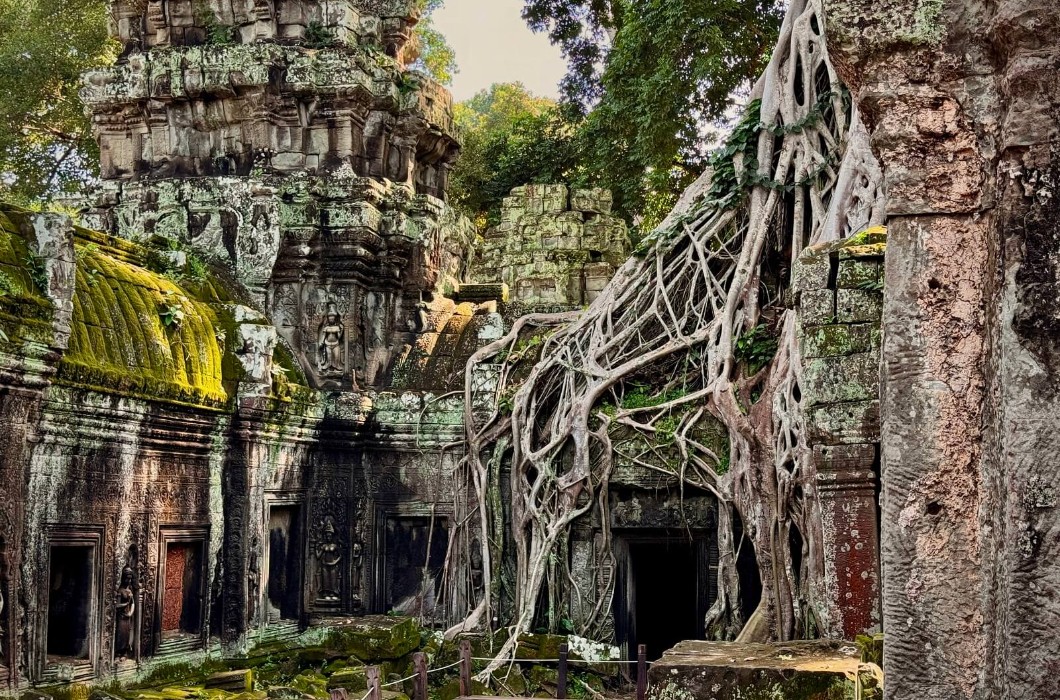
The colonnaded walkways surrounding the lower level are decorated in bas-reliefs depicting scenes from the Ramayana and the Mahabharata, the ancient Hindu texts. Whole galleries are dedicated to epic scenes of battles and legends like the Churning of the Sea of Milk, with legions of warriors and mythical animals like garuda (lion) and naga (serpent) rendered in impossibly vivid detail, accompanied by dancing apsara and characters from the books.
In the early morning light, carved window columns cast mini-Angkor Wat shadows on the wall, while stone-set figures dance around columns and courtyards that lead skywards to the upper levels. From its lofty peak, I can spot other distant temples peeking through the forest canopy and the sanctuary of Phnom Bakheng atop a nearby hill, which hint at the scale of this once-forgotten city.
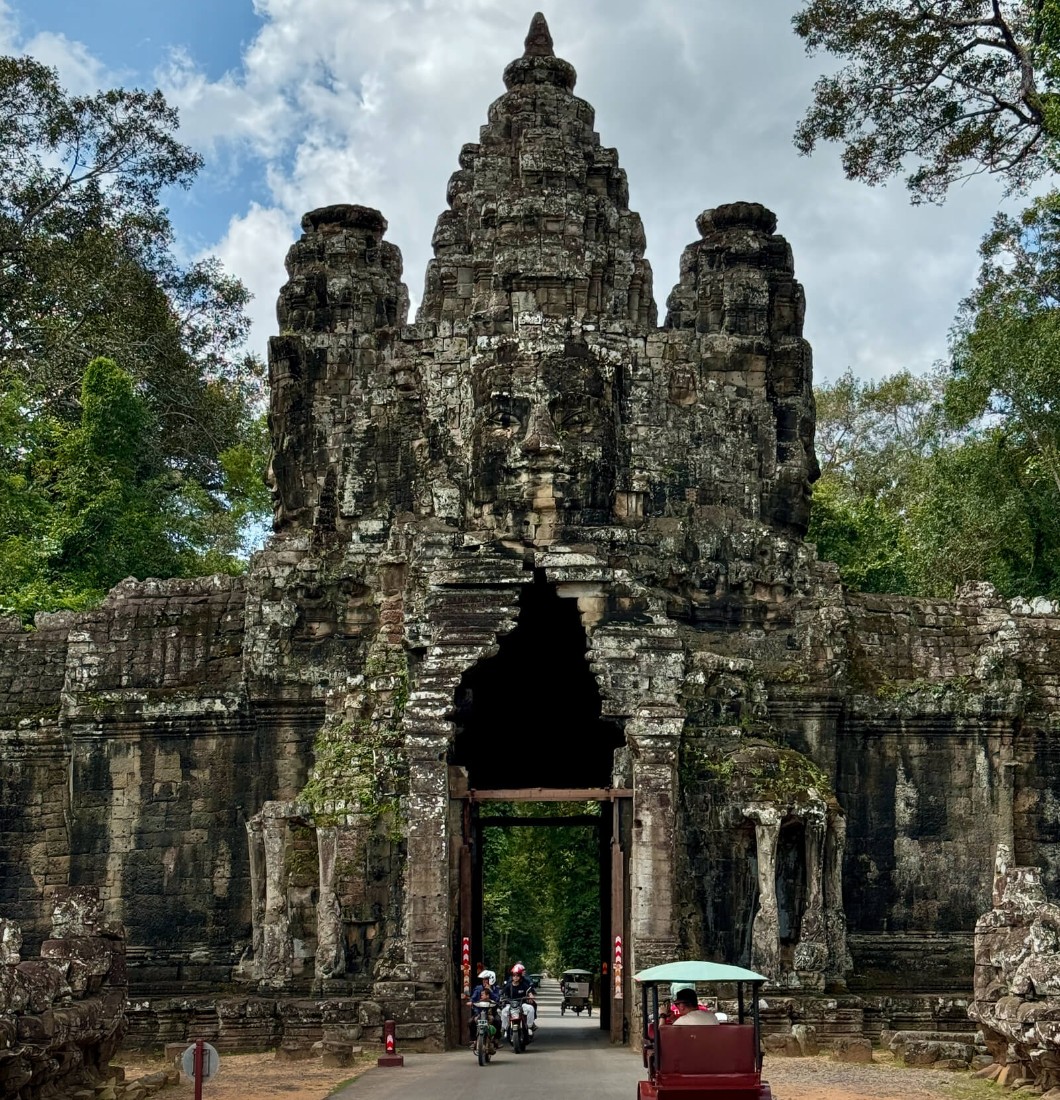
The Amansara remork makes short work of the few kilometres between Angkor Wat and Ta Prohm, the 12th century temple half consumed by the jungle and made famous by the movie Tomb Raider. Strangled by centuries-old tree roots — gargantuan, muscular tentacles engaged in a silent battle to consume it — Ta Prohm is the passage of time made visible, tinged with a hint of the grotesque and an overwhelming sense of mystery. Tumbling stone blocks are held in place by the bulbous roots of strangler fig, kapok and silk-cotton trees, forming a mesh of living and man-made elements.
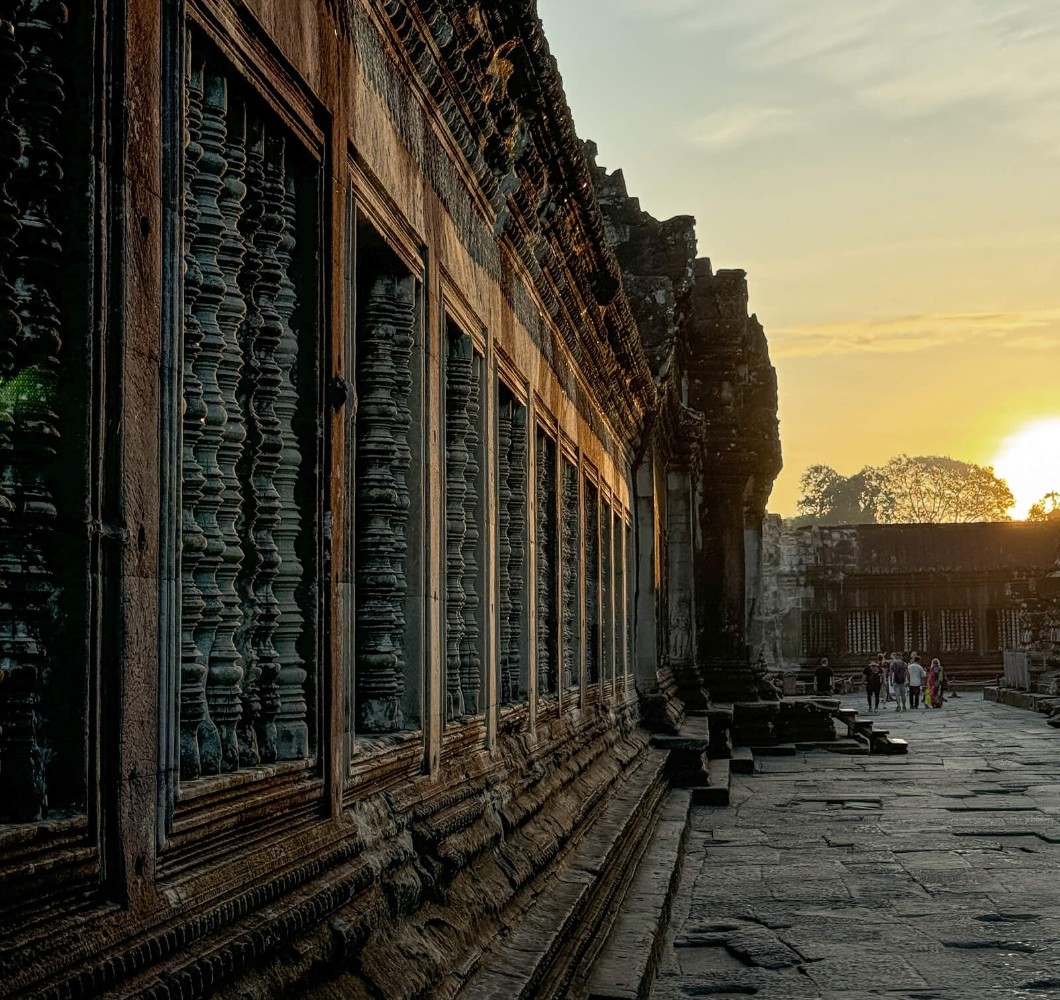
Built by King Jayavarman VII for his mother, Ta Prohm was lost to the jungle along with the rest of Angkor for centuries before it was rediscovered by French archaeologists in the 1840s. Strolling through these formidable temples, it seems implausible that this vast city would be so easily abandoned for the next 500 years.
Theories swirl among academic circles, says Tone: was it conflict with the neighbouring Ayutthataya Kingdom that led to its abandonment, growing economic demands or environmental changes that affected the food and water supply? Since the artisans of Angkor didn’t have time to chronicle the events in stone, the mystery of the city’s rapid decline in the 15th century remains unsolved.
ENIGMATIC BAYON
These and other questions are contemplated over breakfast at Amansara’s Khmer Village House, a traditional silted timber restaurant and cookery school that overlooks the still waters of Srah Srang, a 10th century baray (reservoir). Accompanied by a soundtrack of crowing roosters and giggling village children, a breakfast of Khmer dishes and tropical fruit is served on the terrace as giant black butterflies flit through the organic garden and the ever-present aroma of jasmine drifts on the breeze.
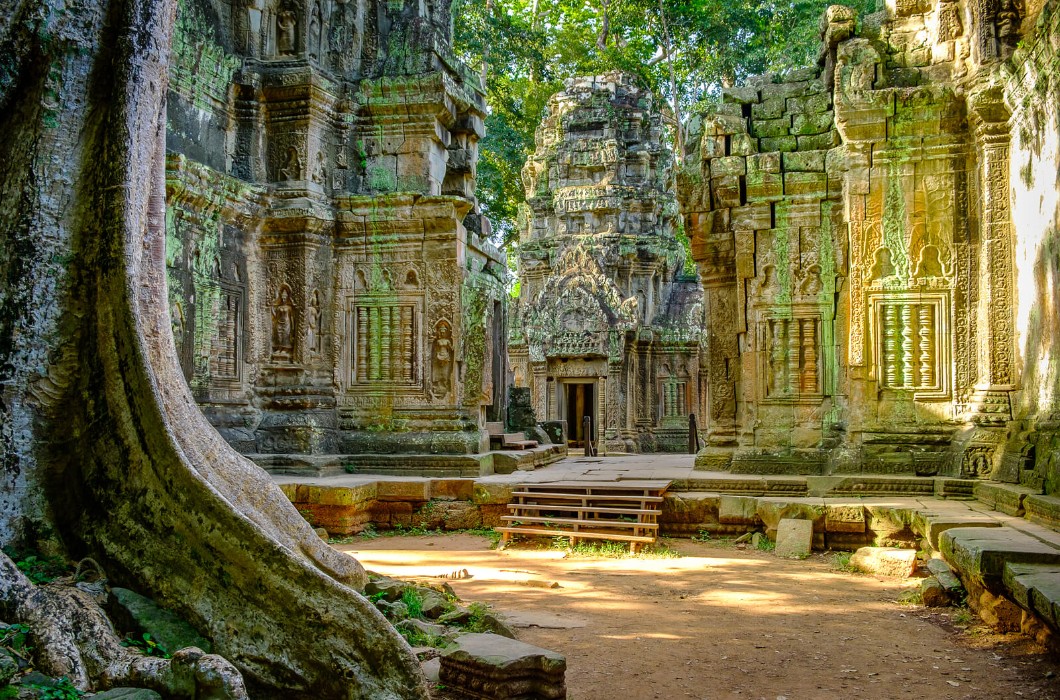
A short drive past centuries-old walls and well-manicured lawns leads to Angkor Thom, the ‘Great City’; a walled complex of terraces, towers, temples and palaces surrounded by a vast moat that was built by Jayavarman VII in the early 13th century. To reach its most formidable entrance, the Victory Gate, we cross a causeway made of two giant serpents pulled by 54 stone giants, demons and other deities engaged in an eternal struggle of good versus evil.
The mighty gate is crowned with the benign, smiling face of the Buddha, symbolic of the transition from predominantly Hindu to Buddhist architectural iconography during the reign of Jayavarman VII as you enter Angkor Thom.
Nowhere is this shift more visible than the temple of Bayon, an Escheresque ruin that’s overlooked by 173 enigmatic stone faces: indifferent, benign, meditative characters, soft eyelids set in peaceful repose, like ancient stone ancestors of the Mona Lisa. Even UNESCO is unable to decide which of the Buddhist deities these faces represent, Buddha, Brahma or “Lord of the World” Bodhisattva Lokesvara, or if they depict Jayavarman VII himself.
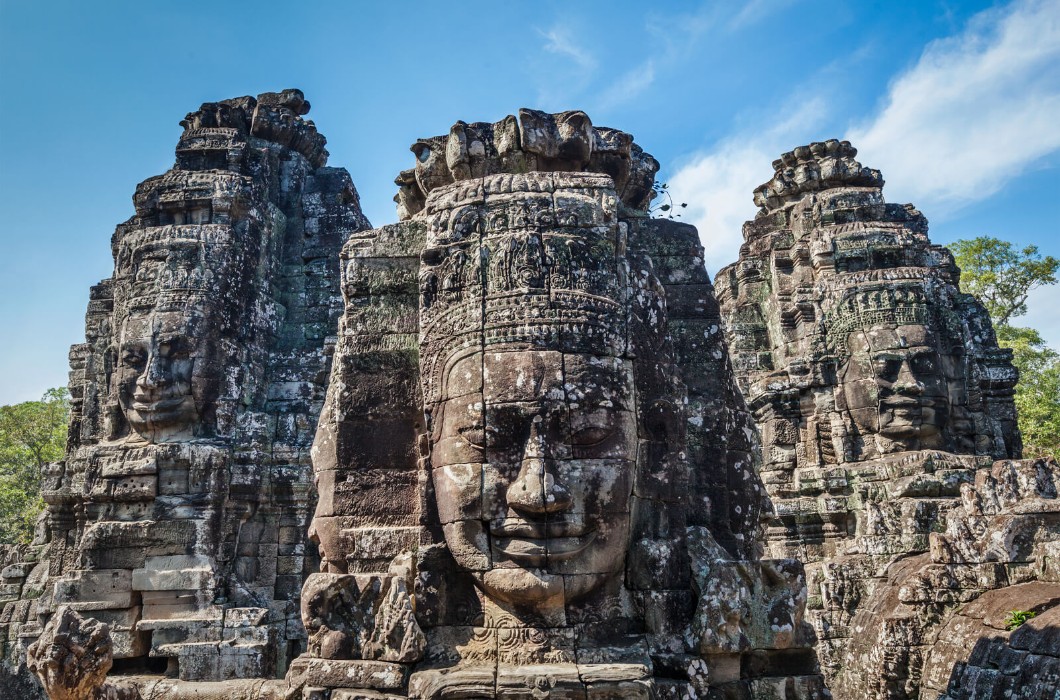
In contrast to Angkor Wat’s mythological imagery, the detailed bas-reliefs in Bayon’s outer gallery show scenes of daily life during the Khmer Empire, with phenomenally detailed murals depicting naval battles, marching armies, royal entertainment and agricultural activities. Between the carvings, the occasional glimpse of a saffron robe serves as a reminder that Bayon and many other temples within Angkor are still places of worship and have been since their story began more than a thousand years ago.
UNFINISHED TALES
Today, the ongoing restoration and safeguarding of Angkor continues under the auspices of UNESCO with the support of conservation teams from around the world. Inscribed on the World Heritage list in 1992, Angkor was removed from the World Heritage in Danger list in 2004 after some essential remedial work. But balancing conservation with the needs of the local community that live within its walls and the enormous demands of Siem Reap’s tourism economy remains a challenge.
As the story of Angkor is painstakingly put back together piece by piece, Siem Reap continues to evolve. This once sleepy riverside town now sees more than two million visitors every year, forcing it to confront the pressures of unrelenting popularity while protecting and advancing its cultural heritage and supporting the needs of its people.

In covered markets and riverside boutiques, artisans practice traditional crafts like woodwork, stone-carving, lacquerware and silk-making, while ateliers weave traditional motifs into modern linen cuts and artists capture the multitude of colours, shapes and shadows that bring the temples of Angkor to life.

Khmer cuisine too is having a revival thanks to a generation of chefs breathing new life into traditional recipes. In the wider region, NGOs and charities continue their work, righting the wrongs of the dark years of the Khmer Rouge, including the Siem Reap Provincial Orphanage — an organisation supported by Amansara.
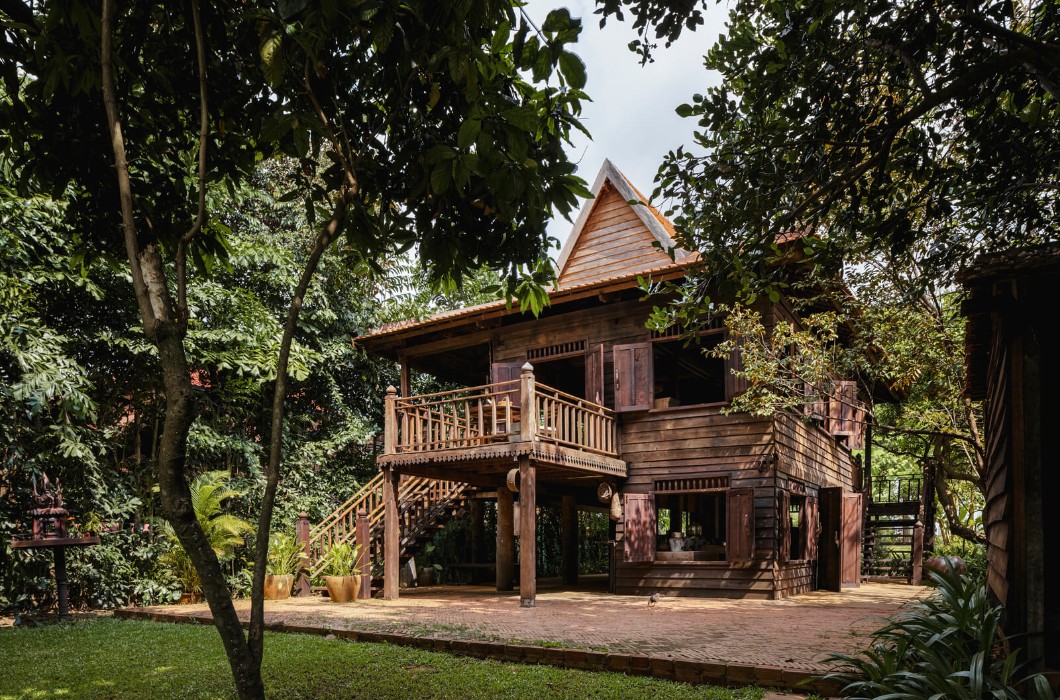
Like the Khmer Empire of old, Cambodia’s fortunes have waxed and waned, but the current chapter is one of hope and revival. The stories of the stones are still being chronicled and the mystery of Angkor’s abandonment remains unclear, adding perhaps to the legend that draws travellers and pilgrims from all over the world,
Back at the hotel, the hypnotic trickle of a water fountain muffles the distant drone of motorcycles as the light begins to fade. The faint aroma of woodsmoke drifts on the breeze, swallows dart in and out of pom-pom treetops to feast on clouds of dragonflies and, on the wall’s blank canvas, the evening’s first geckos begin their hunt for prey. It is a serene moment that brings the day full circle, completing one more page in Angkor’s epic and still-unfolding history.
Aman.com







